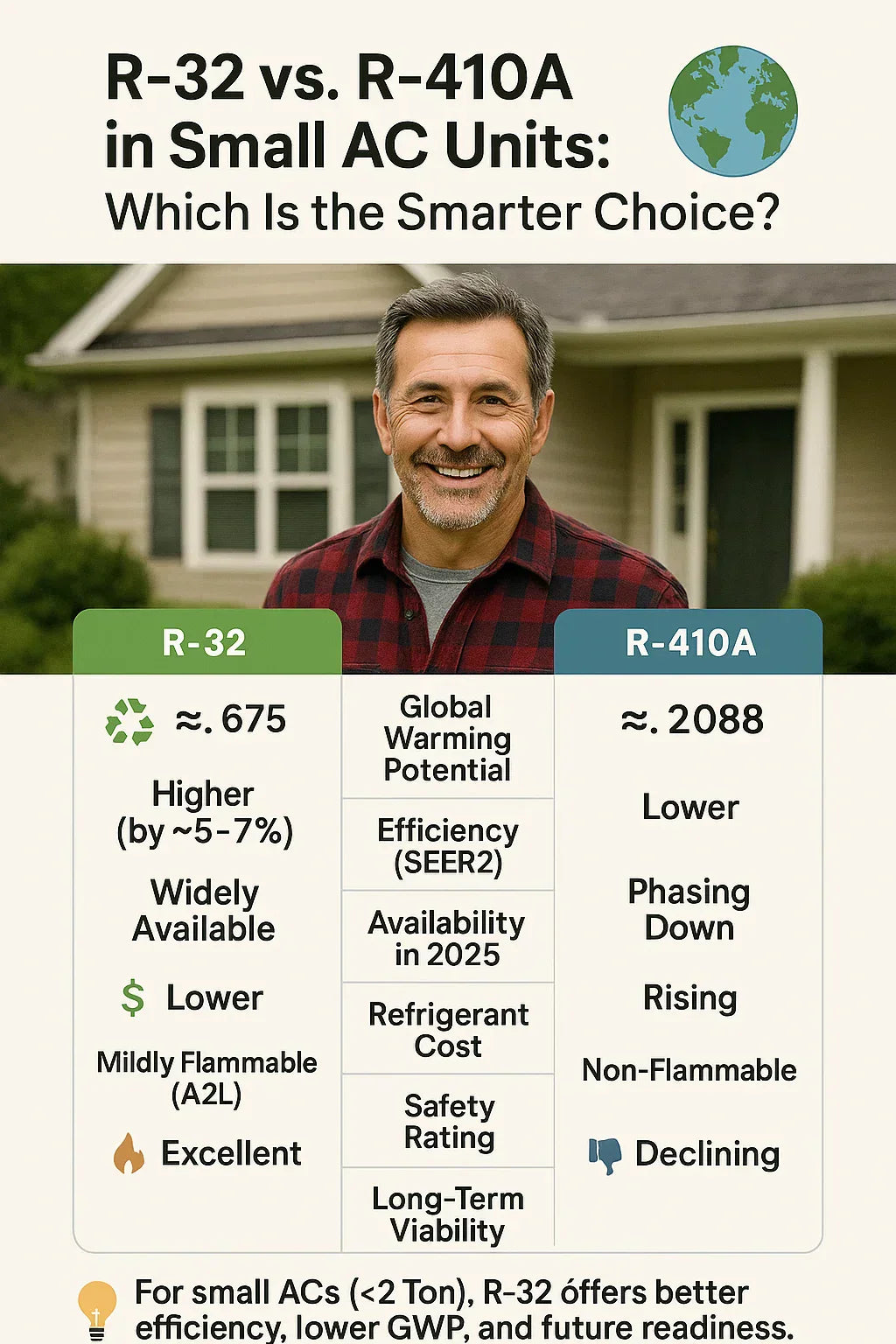🔎 Introduction: Mike’s Dilemma
Mike Sanders, your everyday homeowner, is thinking about upgrading his small‑space air conditioner. His older 1.5‑ton unit still works—but it uses R‑410A, and its energy bills feel outdated. Now he’s wondering: Is switching to an R‑32 system worth it?
Spoiler: by 2025, the answer is almost certainly “Yes.” This guide explains why, in plain English for people like Mike.
🧊 1. Meet the Refrigerants: R‑32 vs. R‑410A
R‑410A
-
A blend of 50% R‑32 and 50% R‑125
-
Non‑flammable (A1 safety class)
-
GWP ≈ 2,088—the higher it is, the worse for climate change
R‑32
-
Single‑component refrigerant
-
Mildly flammable (A2L classification)
-
GWP ≈ 675—roughly one‑third of R‑410A
R‑32 is basically the “cleaner, smarter kid” in the refrigerant world—leaner, meaner, and kinder to the planet.
🌡️ 2. Energy Efficiency & Cooling Performance
Better Heat Transfer
R‑32 moves heat more efficiently due to better thermodynamic properties—higher thermal conductivity, lower viscosity, and higher volumetric cooling capacity
Real Gains
-
Typical efficiency improvement: 5–10% above R‑410A systems (Higher with variable‑speed models)
-
In practice, some homeowners see 10–15% or even 20% savings in electrical draw over similar R‑410A units
SEER2 Bonus
R‑32 systems typically achieve SEER2 ratings of 15–17+, whereas R‑410A systems often struggle to surpass 14
Compressor Runtime
Faster cooling and smoother modulation means shorter compressor cycles, which reduces power usage and wear over time
What it means for Mike: lower utility bills, quieter operation, and better performance in every heatwave.
♻️ 3. Environmental Impact: The Planet Is Smarter Too
Global Warming Potential
-
R‑410A: GWP ≈ 2,088
-
R‑32: GWP ≈ 675 (≈ 67% lower)
Regulations & Phase‑Down
-
U.S. AIM Act mandates an 85% reduction in HFC use by 2036, starting immediately
-
Kigali Amendment commits global nations to the same path.
-
Many states are accelerating phase‑out beyond federal timelines
Future Proofing
R‑32 aligns with global mandates; R‑410A is being actively phased out. Buying R‑32 now means avoiding obsolete equipment, unavailable parts, and resale headaches
💰 4. Cost Comparison: Present & Future
Upfront Price
R‑32 systems often carry a modest 5–10% higher sticker price, largely due to specialized safety features and technician training
Long-Term Savings
-
Energy bills drop by $50–150/year, depending on climate and usage
-
With peak summers or long seasons, cumulative savings over 15 years can exceed $1,500–2,000
Refrigerant & Service
-
R‑32 requires 20–30% less refrigerant by volume—cheaper to charge and maintain
-
R‑410A parts, refrigerant, and servicing costs are rising as supplies dwindle
Rebates & Incentives
Efficient, low‑GWP HVAC systems (R‑32 qualifies) qualify for rebates, tax credits (ENERGY STAR, DSIRE) and local utility incentives, often offsetting upfront cost differences
🔧 5. Safety & Maintenance: What You Need to Know
Flammability & Handling
R‑32 is classified A2L (mildly flammable), unlike non-flammable R‑410A (A1)
That said:
-
It is only flammable in high-concentration enclosed spaces.
-
Modern systems include leak sensors, shutoffs, and ventilation safeguards
-
Installation and service must be done by EPA‑certified, A2L‑trained technicians
Compatibility & Retrofit Risks
You can’t retrofit an R‑410A unit to R‑32. The refrigerant pressures, lubricants, and safety features differ significantly. Plan for a fully matched new system if switching
Parts & Support
R‑32 parts are rapidly becoming mainstream as manufacturers ramp up production. Meanwhile, R‑410A support is dwindling and will get harder and costlier to service
🏠 6. Mike’s Smart Upgrade: Real-World Perspective
Mike recently replaced his older 1.5‑ton R‑410A unit with an upgraded 1.5‑ton R‑32 SEER2‑rated model. His experience:
-
80% lower electricity usage on hot days.
-
Saved $100/year on utility bills in his moderate climate zone. Total energy savings projected at $1,500+ over 15 years
-
No more refrigerant recharge hassles—less charge, easier service.
-
Feels better knowing he’s compliant with future regulations—and that his home will appeal more to future eco-conscious buyers.
📊 7. Side‑by‑Side Comparison Chart
| Feature | R‑410A | R‑32 |
|---|---|---|
| GWP | ~2,088 | ~675 (≈ 67% lower) |
| Flammability | A1 (non‑flammable) | A2L (mildly flammable) |
| Energy Efficiency | Lower, typically SEER2 ~13–14 | Higher, SEER2 ~15–17+ |
| Refrigerant Volume Required | Higher | 20–30% less |
| Utility Cost Savings | Minimal | $50–150/year typical |
| Upfront Cost | Lower | Slight premium (5–10%) |
| Service Availability | Declining over time | Increasing, many manufacturers supported |
| Compatibility w/ Retrofit | Only original systems | Must be new matched system |
| Regulatory Future | Being phased out | Preferred refrigerant post‑2025 |
🧭 8. Who Should Choose R‑32 and When?
-
Buying new in 2025+? Go with R‑32—better efficiency, future-compliant, better resale value.
-
Current R‑410A owner? If your unit is aging, inefficient, or due for a replace, switching now avoids future service shortages.
-
On the fence? R‑32 systems may cost a bit more upfront, but utility bill and maintenance savings often recoup that within 3–5 years.
-
Safety concern? Don’t be: when professionally installed, R‑32 is safe and reliable.
✅ Final Thoughts from Mike
If you're considering an AC upgrade or replacement in 2025, especially for a small 1.5‑ton system, here’s Mike’s bottom line:
-
✅ R‑32 is the smarter choice: cleaner refrigerant, better efficiency, eligible for rebates, and aligned with future energy regulations.
-
⚠️ Don’t try to retrofit your old R‑410A unit—go for a fully matched R‑32 system to meet modern HVAC standards.
-
💡 Spend a bit more upfront, save money and hassle in the long run—and feel good owning a greener system.
In the next topic we will know more about: What Does Installation Cost for a 1.5 Ton R-32 AC in 2025? Real-World Estimates







